+ Open data
Open data
- Basic information
Basic information
| Entry | Database: PDB / ID: 5xxv | |||||||||||||||||||||
|---|---|---|---|---|---|---|---|---|---|---|---|---|---|---|---|---|---|---|---|---|---|---|
| Title | GDP-microtubule complexed with KIF5C in AMPPNP state | |||||||||||||||||||||
 Components Components |
| |||||||||||||||||||||
 Keywords Keywords | STRUCTURAL PROTEIN / Microtubule / KIF5C / Kinesin | |||||||||||||||||||||
| Function / homology |  Function and homology information Function and homology informationmotile cilium / structural constituent of cytoskeleton / microtubule cytoskeleton organization / neuron migration / mitotic cell cycle / Hydrolases; Acting on acid anhydrides; Acting on GTP to facilitate cellular and subcellular movement / microtubule / hydrolase activity / GTPase activity / GTP binding ...motile cilium / structural constituent of cytoskeleton / microtubule cytoskeleton organization / neuron migration / mitotic cell cycle / Hydrolases; Acting on acid anhydrides; Acting on GTP to facilitate cellular and subcellular movement / microtubule / hydrolase activity / GTPase activity / GTP binding / metal ion binding / cytoplasm Similarity search - Function | |||||||||||||||||||||
| Biological species |  | |||||||||||||||||||||
| Method | ELECTRON MICROSCOPY / helical reconstruction / cryo EM / Resolution: 6.46 Å | |||||||||||||||||||||
 Authors Authors | Morikawa, M. / Shigematsu, H. / Nitta, R. / Hirokawa, N. | |||||||||||||||||||||
| Funding support |  Japan, 4items Japan, 4items
| |||||||||||||||||||||
 Citation Citation |  Journal: J Cell Biol / Year: 2018 Journal: J Cell Biol / Year: 2018Title: Kinesin-binding-triggered conformation switching of microtubules contributes to polarized transport. Authors: Tomohiro Shima / Manatsu Morikawa / Junichi Kaneshiro / Taketoshi Kambara / Shinji Kamimura / Toshiki Yagi / Hiroyuki Iwamoto / Sotaro Uemura / Hideki Shigematsu / Mikako Shirouzu / Taro ...Authors: Tomohiro Shima / Manatsu Morikawa / Junichi Kaneshiro / Taketoshi Kambara / Shinji Kamimura / Toshiki Yagi / Hiroyuki Iwamoto / Sotaro Uemura / Hideki Shigematsu / Mikako Shirouzu / Taro Ichimura / Tomonobu M Watanabe / Ryo Nitta / Yasushi Okada / Nobutaka Hirokawa /   Abstract: Kinesin-1, the founding member of the kinesin superfamily of proteins, is known to use only a subset of microtubules for transport in living cells. This biased use of microtubules is proposed as the ...Kinesin-1, the founding member of the kinesin superfamily of proteins, is known to use only a subset of microtubules for transport in living cells. This biased use of microtubules is proposed as the guidance cue for polarized transport in neurons, but the underlying mechanisms are still poorly understood. Here, we report that kinesin-1 binding changes the microtubule lattice and promotes further kinesin-1 binding. This high-affinity state requires the binding of kinesin-1 in the nucleotide-free state. Microtubules return to the initial low-affinity state by washing out the binding kinesin-1 or by the binding of non-hydrolyzable ATP analogue AMPPNP to kinesin-1. X-ray fiber diffraction, fluorescence speckle microscopy, and second-harmonic generation microscopy, as well as cryo-EM, collectively demonstrated that the binding of nucleotide-free kinesin-1 to GDP microtubules changes the conformation of the GDP microtubule to a conformation resembling the GTP microtubule. | |||||||||||||||||||||
| History |
|
- Structure visualization
Structure visualization
| Movie |
 Movie viewer Movie viewer |
|---|---|
| Structure viewer | Molecule:  Molmil Molmil Jmol/JSmol Jmol/JSmol |
- Downloads & links
Downloads & links
- Download
Download
| PDBx/mmCIF format |  5xxv.cif.gz 5xxv.cif.gz | 1.3 MB | Display |  PDBx/mmCIF format PDBx/mmCIF format |
|---|---|---|---|---|
| PDB format |  pdb5xxv.ent.gz pdb5xxv.ent.gz | 1 MB | Display |  PDB format PDB format |
| PDBx/mmJSON format |  5xxv.json.gz 5xxv.json.gz | Tree view |  PDBx/mmJSON format PDBx/mmJSON format | |
| Others |  Other downloads Other downloads |
-Validation report
| Summary document |  5xxv_validation.pdf.gz 5xxv_validation.pdf.gz | 2 MB | Display |  wwPDB validaton report wwPDB validaton report |
|---|---|---|---|---|
| Full document |  5xxv_full_validation.pdf.gz 5xxv_full_validation.pdf.gz | 2.5 MB | Display | |
| Data in XML |  5xxv_validation.xml.gz 5xxv_validation.xml.gz | 285.8 KB | Display | |
| Data in CIF |  5xxv_validation.cif.gz 5xxv_validation.cif.gz | 384.1 KB | Display | |
| Arichive directory |  https://data.pdbj.org/pub/pdb/validation_reports/xx/5xxv https://data.pdbj.org/pub/pdb/validation_reports/xx/5xxv ftp://data.pdbj.org/pub/pdb/validation_reports/xx/5xxv ftp://data.pdbj.org/pub/pdb/validation_reports/xx/5xxv | HTTPS FTP |
-Related structure data
| Related structure data |  6781MC  6779C  6782C  6783C  5xxtC  5xxwC  5xxxC C: citing same article ( M: map data used to model this data |
|---|---|
| Similar structure data |
- Links
Links
- Assembly
Assembly
| Deposited unit | 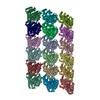
|
|---|---|
| 1 |
|
- Components
Components
-Protein , 2 types, 18 molecules ACEGIKMOQBDFHJLNPR
| #1: Protein | Mass: 48638.793 Da / Num. of mol.: 9 / Fragment: UNP residues 2-439 / Source method: isolated from a natural source / Source: (natural)  #2: Protein | Mass: 47809.746 Da / Num. of mol.: 9 / Fragment: UNP residues 2-427 / Source method: isolated from a natural source / Source: (natural)  |
|---|
-Non-polymers , 4 types, 63 molecules 






| #3: Chemical | ChemComp-MG / #4: Chemical | ChemComp-GTP / #5: Chemical | ChemComp-GDP / #6: Water | ChemComp-HOH / | |
|---|
-Details
| Has protein modification | Y |
|---|
-Experimental details
-Experiment
| Experiment | Method: ELECTRON MICROSCOPY |
|---|---|
| EM experiment | Aggregation state: FILAMENT / 3D reconstruction method: helical reconstruction |
- Sample preparation
Sample preparation
| Component | Name: GDP-microtubule complexed with KIF5C in AMPPNP state / Type: ORGANELLE OR CELLULAR COMPONENT / Entity ID: #1-#2 / Source: RECOMBINANT |
|---|---|
| Molecular weight | Experimental value: NO |
| Source (natural) | Organism:  |
| Source (recombinant) | Organism: Plasmid: pET21b |
| Buffer solution | pH: 7.4 |
| Specimen | Embedding applied: NO / Shadowing applied: NO / Staining applied: NO / Vitrification applied: YES |
| Specimen support | Grid material: COPPER / Grid mesh size: 200 divisions/in. / Grid type: Quantifoil R2/2 |
| Vitrification | Instrument: FEI VITROBOT MARK IV / Cryogen name: ETHANE / Humidity: 100 % / Chamber temperature: 300 K |
- Electron microscopy imaging
Electron microscopy imaging
| Experimental equipment |  Model: Talos Arctica / Image courtesy: FEI Company |
|---|---|
| Microscopy | Model: FEI TECNAI ARCTICA |
| Electron gun | Electron source:  FIELD EMISSION GUN / Accelerating voltage: 200 kV / Illumination mode: FLOOD BEAM FIELD EMISSION GUN / Accelerating voltage: 200 kV / Illumination mode: FLOOD BEAM |
| Electron lens | Mode: BRIGHT FIELD / Cs: 2.7 mm |
| Image recording | Electron dose: 50 e/Å2 / Film or detector model: FEI FALCON II (4k x 4k) |
- Processing
Processing
| EM software | Name: FREALIGN / Version: 9 / Category: 3D reconstruction |
|---|---|
| CTF correction | Type: PHASE FLIPPING AND AMPLITUDE CORRECTION |
| Helical symmerty | Angular rotation/subunit: -25.768 ° / Axial rise/subunit: 8.6237 Å / Axial symmetry: C1 |
| 3D reconstruction | Resolution: 6.46 Å / Resolution method: FSC 0.143 CUT-OFF / Num. of particles: 8507 / Symmetry type: HELICAL |
| Atomic model building | Protocol: RIGID BODY FIT |
 Movie
Movie Controller
Controller



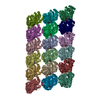
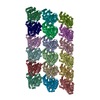
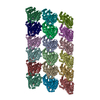
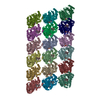
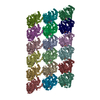
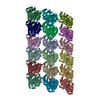
 PDBj
PDBj






